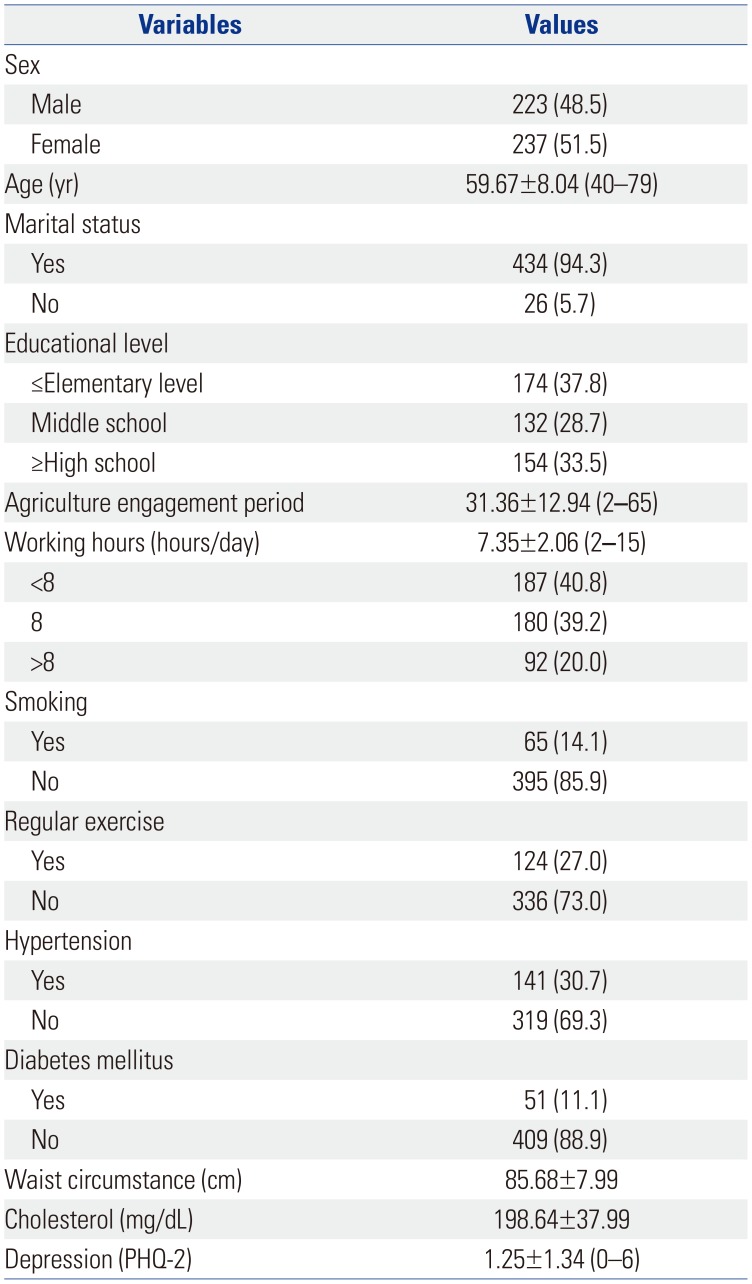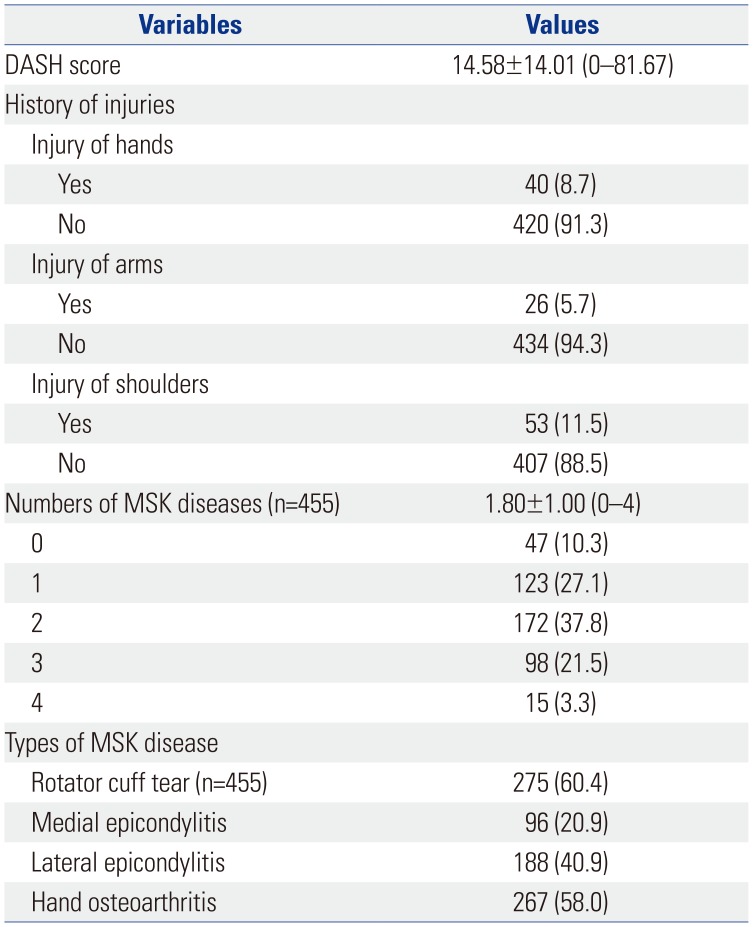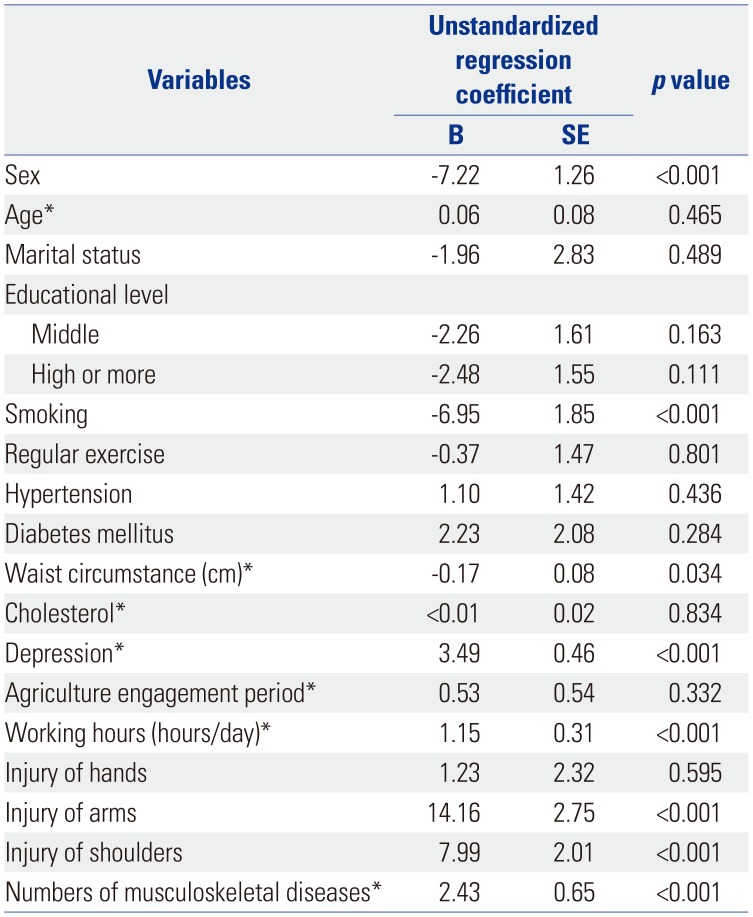2. Osborne A, Blake C, Fullen BM, Meredith D, Phelan J, McNamara J, et al. Prevalence of musculoskeletal disorders among farmers: a systematic review. Am J Ind Med. 2012; 55:143–158. PMID:
22069159.

3. Min D, Baek S, Park HW, Lee SA, Moon J, Yang JE, et al. Prevalence and characteristics of musculoskeletal pain in Korean farmers. Ann Rehabil Med. 2016; 40:1–13. PMID:
26949663.

4. Nonnenmann MW, Anton D, Gerr F, Merlino L, Donham K. Musculoskeletal symptoms of the neck and upper extremities among Iowa dairy farmers. Am J Ind Med. 2008; 51:443–451. PMID:
18404686.

5. da Costa BR, Vieira ER. Risk factors for work-related musculoskeletal disorders: a systematic review of recent longitudinal studies. Am J Ind Med. 2010; 53:285–323. PMID:
19753591.

6. Rosecrance J, Rodgers G, Merlino L. Low back pain and musculoskeletal symptoms among Kansas farmers. Am J Ind Med. 2006; 49:547–556. PMID:
16685722.

7. Suh YS, Cheon YH, Kim JO, Kim RB, Park KS, Yang HS, et al. Prevalence and risk factors of upper extremity musculoskeletal diseases among farmers in Gyeongnam. J Rheum Dis. 2015; 22:366–373.

8. Fethke NB, Merlino LA, Gerr F, Schall MC Jr, Branch CA. Musculoskeletal pain among Midwest farmers and associations with agricultural activities. Am J Ind Med. 2015; 58:319–330. PMID:
25345841.

9. Salaffi F, De Angelis R, Stancati A, Grassi W. MArche Pain. Prevalence INvestigation Group (MAPPING) study. Health-related quality of life in multiple musculoskeletal conditions: a cross-sectional population based epidemiological study. II. The MAPPING study. Clin Exp Rheumatol. 2005; 23:829–839. PMID:
16396701.
10. Kroenke K, Spitzer RL, Williams JB. The Patient Health Questionnaire-2: validity of a two-item depression screener. Med Care. 2003; 41:1284–1292. PMID:
14583691.
11. Sluiter JK, Rest KM, Frings-Dresen MH. Criteria document for evaluating the work-relatedness of upper-extremity musculoskeletal disorders. Scand J Work Environ Health. 2001; 27(Suppl 1):1–102.
12. Kellgren JH, Lawrence JS. Radiological assessment of osteo-arthrosis. Ann Rheum Dis. 1957; 16:494–502. PMID:
13498604.

13. Haugen IK, Englund M, Aliabadi P, Niu J, Clancy M, Kvien TK, et al. Prevalence, incidence and progression of hand osteoarthritis in the general population: the Framingham Osteoarthritis Study. Ann Rheum Dis. 2011; 70:1581–1586. PMID:
21622766.

14. Hudak PL, Amadio PC, Bombardier C. Development of an upper extremity outcome measure: the DASH (disabilities of the arm, shoulder and hand) [corrected]. The Upper Extremity Collaborative Group (UECG). Am J Ind Med. 1996; 29:602–608. PMID:
8773720.
15. Lee JY, Lim JY, Oh JH, Ko YM. Cross-cultural adaptation and clinical evaluation of a Korean version of the disabilities of arm, shoulder, and hand outcome questionnaire (K-DASH). J Shoulder Elbow Surg. 2008; 17:570–574. PMID:
18472283.

16. Kim KR, Lee KS, Kim HC, Ko ES, Song EY. Health condition and musculoskeletal disorders (MSDs) in fruit-growers. Korean J Community Living Sci. 2009; 20:5–17.
17. Choi YJ, Gim GM, Lee JY, Kang KH. A longitudinal analysis on farm and house work of farm couples: 1964-2005. Korean J Agric Extension. 2006; 13:287–298.
18. Wijnhoven HA, de Vet HC, Picavet HS. Prevalence of musculoskeletal disorders is systematically higher in women than in men. Clin J Pain. 2006; 22:717–724. PMID:
16988568.

19. Xiao H, McCurdy SA, Stoecklin-Marois MT, Li CS, Schenker MB. Agricultural work and chronic musculoskeletal pain among Latino farm workers: the MICASA study. Am J Ind Med. 2013; 56:216–225. PMID:
23023585.

20. Lee SJ, Park HJ. Work-related musculoskeletal disorders among agricultural workers. J Ergon Soc Korea. 2011; 30:525–534.









 PDF
PDF ePub
ePub Citation
Citation Print
Print



 XML Download
XML Download